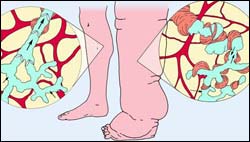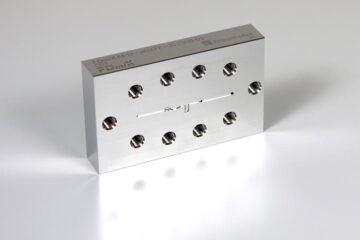Breakthrough in understanding of hereditary disease of lymphatic vessels

Normal lymphatic capillaries (light blue) are devoid of smooth muscle cells, whereas the collecting lymphatic vessels are surounded by a smooth muscle cell layer (orange), which pumps the lymph forward. They also contain valves that prevent the backflow of the lymph. The lymphatic capillaries in the legs of patients who have FOXC2 mutations are abnormally shaped and surrounded by smooth muscle cells. This prevents the efficient uptake and flow of the lymph. Lack of valves in the collecting lymphatics leads to lymph backflow. (Drawing by Paula Saarinen)
A study from the Ludwig Institute for Cancer Research (LICR) Affiliate Center at the University of Helsinki in Finland has shed light on the development of lymphatic vasculature and valves, and may help to develop better treatments for lymphedema.
The disease, which results from damaged or absent lymphatic vessels, may be inherited or may be a side-effect of the surgical removal of tumors. Lymphatic vessels normally remove fluid and proteins escaping from blood capillaries into surrounding tissues, and lymphedema is characterized by the disabling swelling of legs, and sometimes arms, that results when the lymphatic vessels are unable to clear the lymph from the tissues. The current study, which was published today in Nature Medicine, has uncovered a fundamental mechanism of the formation of lymphatic vessels.
The LICR team, together with collaborators from the UK, Japan, USA and Austria, analyzed a hereditary form of lymphedema, known as Lymphedema Distichiasis (LD), which is caused by mutations in a gene called FOXC2. The team found that the lymphatic vessels of LD patients are abnormally shaped and covered with smooth muscle cells that are usually present only on blood vessels and on larger, collecting lymphatic vessels. In addition, mutations in Foxc2 led to a lack of lymphatic valves, which prevent the reflux of lymph. This is the first study that describes a gene critical for the formation of lymphatic valves, and regulation of the interaction between lymphatic endothelial cells and vascular smooth muscle cells.
According to Professor Kari Alitalo, the senior author of the study, the insights gleaned into FOXC2 function may be applicable in the development of therapies for several disorders that affect lymphatic vessel formation. “We are currently working on approaches to stimulate the proper formation of lymphatic vessels in people who suffer from lymphedema. However, FOXC2 is produced in endothelial cells of both lymphatic and venous valves, so these results may also turn out to be important for the understanding and treatment of chronic venous insufficiency, which affects 5-25 % of the adult population.”
Media Contact
More Information:
http://www.licr.orgAll latest news from the category: Health and Medicine
This subject area encompasses research and studies in the field of human medicine.
Among the wide-ranging list of topics covered here are anesthesiology, anatomy, surgery, human genetics, hygiene and environmental medicine, internal medicine, neurology, pharmacology, physiology, urology and dental medicine.
Newest articles

For microscopic organisms, ocean currents act as ‘expressway’ to deeper depths
New research shows how tiny plant-like organisms hitch a ride on ocean currents to reach darker and deeper depths, where they impact carbon cycling and microbial dynamics in the subtropical…

FDmiX: Fast, robust series production of nanoparticles
Nucleic acid-based medications such as mRNA vaccines are opening up new therapeutic approaches. These active ingredients must be enclosed inside nanoparticles to ensure that they get to where they are…

Sensor measures oxygen content of breath
Oxygen saturation in the blood that is either too low or too high can cause physical harm or even death. This is why patients’ oxygen concentraions are monitored continuously in…





















